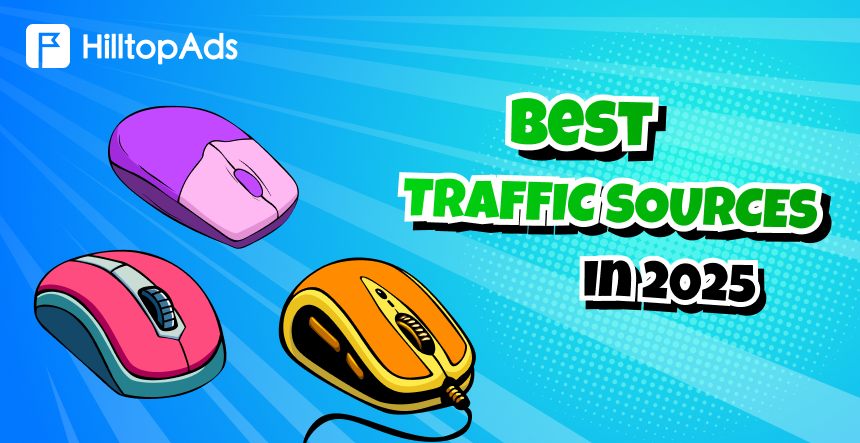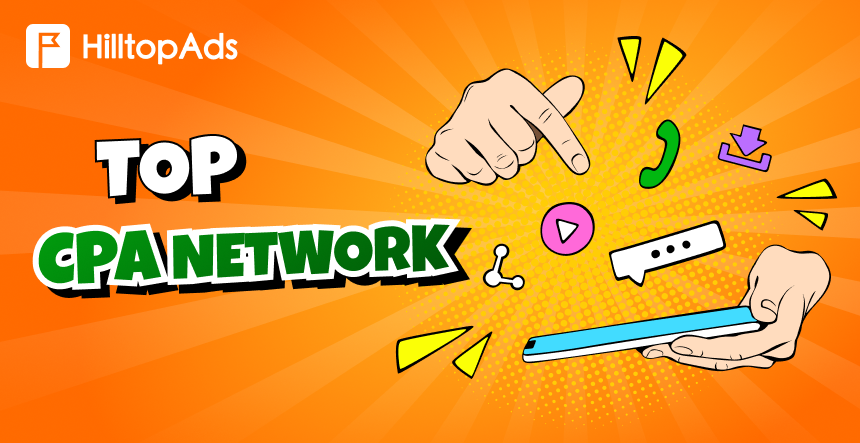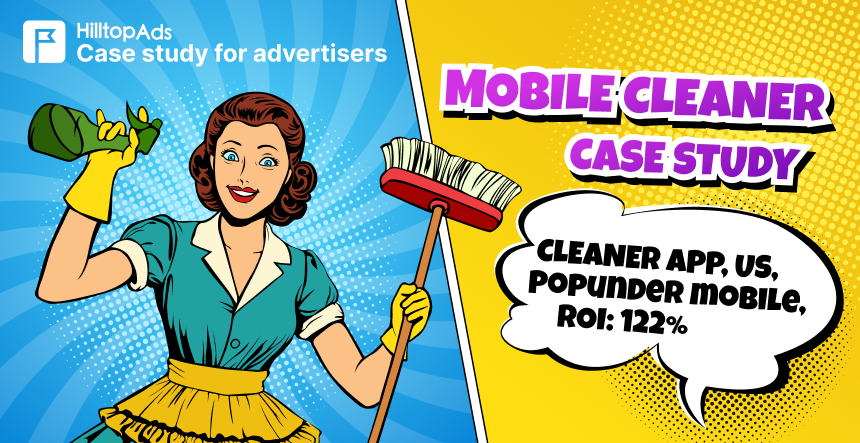This guide lays out the 7 most profitable traffic sources to leverage in 2025, complete with real conversion data and actionable strategies. You will learn what channels have the best ROI, how to select the best source for your business, and why monitoring where your website traffic comes from can make or break your success.

HilltopAds – the best traffic source for your offers
What Is a Traffic Source?
A traffic source tells you where your website visitors were before they landed on your site. Each click gives you a glimpse into user intent and purchasing patterns.
Understanding traffic sources helps you see which marketing channels actually drive sales versus those that just burn through budgets. For instance, if organic search (SEO) visitors convert at 4.1% while display ads typically convert at just 0.39 to 1.08%, it means that one organic visitor is worth several display ad clicks. This doesn’t mean you should abandon display entirely, but it shows that relying on it as your primary channel can drain your budget fast.
By contrast, investing more into SEO and content marketing could give you higher ROI in the long term. In practice, these numbers help you prioritize: allocate a larger share of resources toward proven, high-conversion channels while using lower-performing ones for retargeting or awareness campaigns. Your media buying strategy becomes data-driven rather than guesswork.
Many beginners think ‘traffic source’ is just about where visitors come from, but it’s actually much more strategic than that.
Traffic source is the placement of user traffic that’s directed to the client’s offer/campaign. In other words, it’s the channels that advertisers use to promote an offer, whether that’s through popunders, video pre-roll ads, banners, or other formats.
Main factors that drive traffic from each source are cost, restrictions, amount of traffic, overall quality of traffic and more. When you thoroughly understand your traffic sources you’ll be able to create smarter targeting strategies and optimize your campaigns for success.
Read our new article about the Top 15 best CPA networks:
The 7 Types of Traffic Sources that will Increase Conversions
Traffic sources fall into two main categories: organic and paid. Organic traffic comes from non-paid channels such as SEO, referrals, or social media mentions. It usually delivers higher-quality leads over the long term. Paid traffic comes from ads, which are quick to scale but entirely dependent on budget and often less consistent in conversions.
Understanding this distinction matters because it shapes how you approach each source: organic builds sustainable growth, while paid drives quick results. With that in mind, let’s look at the seven traffic sources that can boost conversions in 2025.
Direct Traffic
When visitors type your URL into their browser or click a bookmark, you receive direct traffic. On average, this traffic converts at 3.7%, partly because many of these users already know your brand and visit with strong intent. However, direct traffic is also the hardest to interpret: analytics tools can’t always show where it came from, and in some cases, bot activity is mixed in. That’s why marketers see it as valuable for conversions and tricky for analysis.
Pros
- Highest conversion rates among all sources
- Indicates strong brand loyalty
- Cost-effective long-term traffic
Cons
- Difficult to scale quickly
- Requires significant brand-building investment
Organic Search
Organic search delivers traffic from unpaid search engine results. SEO-driven organic visits average 4.1% conversion rates across all industries, leading all other channels for qualified website visitors.
Organic traffic comes through search engine optimization (SEO). Marketers create content that ranks well for relevant keywords, attracting users who are already searching for solutions or products. Examples include Google search results and Bing listings where users have high purchase intent.
Pros
- Highest conversion rates available
- Becomes a steady, ongoing source once built
- Cost-effective over time
Cons
- Takes some time to see results
- Algorithm changes can impact rankings
Referral Traffic
Referral traffic is generated through links on external websites. Referral traffic has a 3.3% conversion rate and comes from websites that actively recommend your brand through links.
News articles, directory listings, and partner sites are classic examples. As a result of the curated recommendations, users usually have moderate to high intent.
Pros
- Pre-warmed leads from trusted sources
- Builds domain authority
- Often high-quality, engaged visitors
Cons
- Requires relationship building
- Can be vulnerable to changes if partner sites remove or update links
Social Media Traffic
Social media traffic refers to the sharing of content and community engagement through paid advertising on platforms like Facebook, Instagram, TikTok, and LinkedIn. Social media accounts for 16% of all website traffic, with organic social conversion at 3.1% and paid social media traffic at 2.4%. By 2025, global social commerce sales are predicted to reach $1.2 trillion.
Some types of social media traffic are via Facebook posts, Instagram Stories, TikTok videos, LinkedIn articles, and Twitter (X) threads.
Pros
- Massive audience reach potential
- Visual content performs exceptionally well
- Strong engagement and community building
- Effective for brand awareness
Cons
- Algorithm changes affect organic reach
- Requires consistent content creation
- Platform dependency risks
- Lower conversion rates than search traffic
Email Marketing
Email marketing performance varies depending on the type of campaign. Promotional and sales-driven emails with open rates around 60% achieve strong results. By comparison, content-driven newsletters usually see lower open rates of about 30%, since their goal is to nurture engagement and build long-term trust rather than drive immediate sales.
Subscribers will receive targeted messages that direct them to your website for specific actions. Examples include weekly newsletters, product launch announcements, abandoned cart emails, and promotional campaigns. When people opt in, they’re taking an action that shows intent.
Pros
- Direct channel to engaged audience
- High ROI potential
- Precise targeting and personalization
- Owned media not dependent on algorithms
Cons
- Requires list-building time and effort
- Deliverability challenges with spam filters
- Subscriber fatigue if overused
Display Advertising
Display ads include banner, native, and remarketing placements. The share of traffic from display varies widely by industry, budget, and mix, so a single percentage isn’t reliable. Across large benchmarks, display conversion rates range from 0.39 to 1.08%.
Display advertising works through programmatic ad buying. That is, it places visual ads on websites relevant to where your target audience spends time. Some examples are the banner ads on news sites, native ads found on content feeds, and remarketing ads that follow users offsite. The outcome of an ad depends on its placement and targeting.
Pros
- Excellent for brand awareness and reach
- Sophisticated targeting options available
- Visual impact drives engagement
Cons
- Lower conversion rates than search
- Higher costs for premium placements
- Requires compelling creative design
Paid Search
Paid search captures high-intent users who are actively looking for solutions. On average, conversion rates for paid search advertising are around 3.2% across sectors. Because these visitors are already searching for specific products or answers, they tend to convert more readily than users from colder channels.
Paid search uses services like Google Ads and Bing Ads to display ads above organic listings, based on certain keywords. Ad buyers make bids on the keywords relevant to their offering.
Pros
- Immediate results and traffic
- High-purchase-intent users
- Precise keyword targeting
- Measurable ROI and performance
Cons
- Can be expensive for competitive keywords
- Requires ongoing optimization and management
- Stops immediately when budget runs out
Use HilltopAds to promote your campaigns and get
- Direct traffic sources
- Advanced targeting options
- Self-serve platform
- Fully-managed service
- Postback tracking
Best Traffic Sources in 2025
Some traffic sources convert significantly better than others, and this comparison shows which channels actually generate profit versus those that mainly drain budgets.
| Traffic Source | Type | Best For | Conversion Rate | ROI Potential |
| Organic Search | Organic | High-intent users seeking solutions | 4.1% | Very High |
| Direct | Organic | Brand-loyal customers | 3.7% | Very High |
| Referral | Organic | Authority building & partnerships | 3.3% | High |
| Paid/Organic | Nurturing existing relationships | 3.0% | High | |
| Social (Organic) | Organic | Brand awareness & engagement | 3.1% | Medium |
| Paid Search | Paid | Immediate results & high intent | 3.2% | Medium-High |
| Social (Paid) | Paid | Targeted demographics | 2.4% | Medium |
| Display | Paid | Remarketing & brand awareness | 0.39 – 1.08% | Medium |
Do certain traffic sources work better for specific industries?
Absolutely! Our top-performing ad format, Popunder (especially mobile), for instance, works really well for iGaming, e-commerce, dating, adult offers, and utility apps such as VPN and cleaners.
Pro tip: If you want to get better conversions on your other ad formats (video, banner, in-page push), you will need some striking visuals that will grab the user’s attention right away for your product. Always try A/B split testing with different creatives; you’ll be surprised which creatives convert the best. Don’t think you know the audience until you test it out!
How to Choose the Best Traffic Source
Choosing the wrong traffic source can eat through your marketing budget. But what makes the difference between a profitable campaign and a costly pit? Four key factors:
Purpose
Define your primary goal before selecting sources. Social media and display ads are best for brand awareness campaigns. But search-based traffic helps with immediate sales. Lead generation benefits from email and content marketing.
Budget
Your available budget determines which sources you can pursue effectively. Organic sources like SEO require time investment but minimal ongoing costs. Paid sources like search ads need consistent budget allocation but deliver faster results.
Target Audience & Industry
Different demographics prefer different platforms. 82% of Gen Z have TikTok profiles, while older audiences lean toward Facebook and email. B2B customers often respond better to LinkedIn and search marketing.
Volume Required
Paid sources or pre-established organic channels often meet the need for high-volume traffic. Most new businesses launch with paid traffic for quick results while developing organic sources for sustainability.
What’s your advice for marketers with a limited budget who want to start testing traffic sources without wasting money?
First, check our current top verticals by ad formats and choose one from that list. Start with a few geos so you won’t overspend if your budget is tight.
If you can set up postback tracking, add automatic optimization to your campaign. This helps get sources automatically blacklisted based on your conversion terms. Also set up appealing prelanders or creatives, depending on your chosen format.
Read our new article about the Best Affiliate Gambling Programs:
Why is it important to measure website traffic sources?
Tracking traffic sources has three key benefits for business:
Identify underperforming channels
Measuring both traffic and conversions shows whether a channel is simply bringing visitors or actually creating customers. This helps you cut back on sources that generate clicks but not sales.
Understand audience behavior
Source data reveals where different audiences spend their time and how they interact with your brand. For example, LinkedIn may generate more qualified B2B leads than Facebook, even if Facebook drives a larger share of traffic.
Plan budgets more effectively
By distinguishing between channels that deliver volume and those that deliver conversions, you can increase investment in the sources that truly generate profit while reducing spend on those that don’t. This creates predictability and maximizes ROI.

Track traffic sources in HilltopAds
and keep only the effective ones using the WhiteList tool
Why HilltopAds Is the Best Traffic Source
HilltopAds is an advertising network that rightfully stands out as one of the best traffic sources for advertisers and media buyers. The platform delivers access to over 273+ billion ad impressions each month across 250+ countries and regions, covering premium Tier-1 markets such as the US, UK, and Canada, as well as fast-growing regions in Asia, Latin America, and Africa with Popunder, In-Page, Video and Banner ad formats. This global reach enables brands and businesses to launch campaigns of any scale — from local initiatives to worldwide promotions — and precisely target the audiences that best match their goals.
What makes HilltopAds especially valuable for advertisers is its high-quality traffic and advanced targeting capabilities. The network’s proprietary anti-fraud system continuously monitors and filters out bots and low-quality sources, ensuring that advertisers reach only real users with genuine conversion potential. In addition, HilltopAds provides audience segmentation based on user activity, real-time transparent analytics, and AI-optimization tools. This combination allows advertisers not only to control costs but also to effectively scale their campaigns while maintaining a high ROI. The proven results of countless advertisers demonstrate that HilltopAds delivers stable, predictable performance, making it a reliable and profitable traffic source for businesses of all kinds. Check out our advertiser case studies and see for yourself:
Final Words
Most media buyers waste budgets on blind tests. The smart ones track conversions first, then scale what works. Organic and direct traffic often bring the highest conversion rates, while paid sources deliver faster results.
Avoid putting all your budget into one channel. Instead, spread resources across proven converters, paid campaigns, organic growth, and a small portion for testing. The exact mix depends on your industry and goals. Mobile usually brings higher volumes, while desktop visitors spend more per conversion.
Lastly, remember industry matters: search-based traffic suits healthcare and professional services, while social platforms work better for visual sectors like fashion.
What’s trending in 2025 for media buyers and affiliate marketers?
The AI dating niche is quite popular right now. There are several new interesting AI services gaining popularity and attention these days. As for sources to test, we have an improved CPAGoal campaign type that allows you to set up campaigns based on the required conversion cost. This provides you greater financial control and more predictable outcomes.
Testing multiple traffic sources usually means dealing with countless platforms and tracking nightmares. HilltopAds handles the heavy lifting with 273+ billion monthly impressions and real-time conversion tracking. Start with $100, pick your sources, and see which ones actually convert for your offers.























